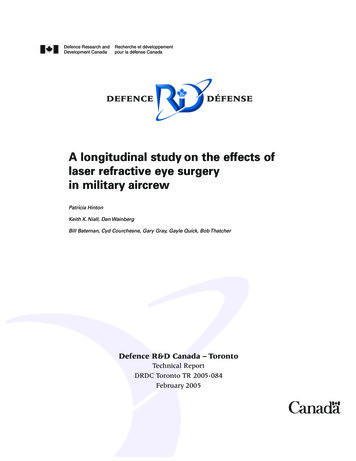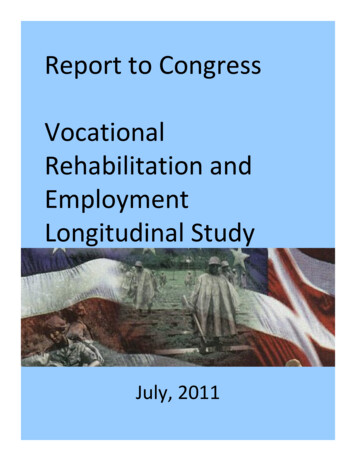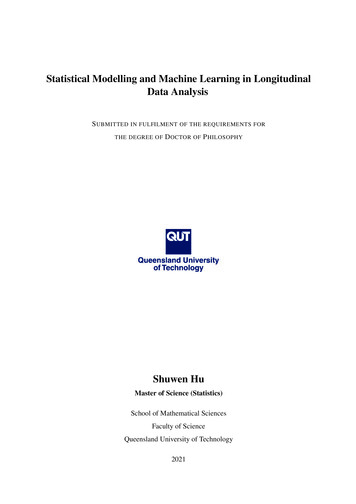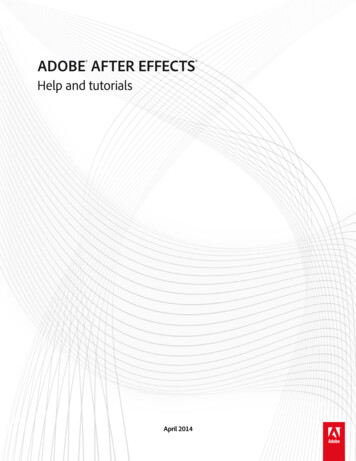
Transcription
Defence Research andDevelopment CanadaRecherche et développementpour la défense CanadaDEFENCE&DÉFENSEA longitudinal study on the effects oflaser refractive eye surgeryin military aircrewPatricia HintonKeith K. Niall, Dan WainbergBill Bateman, Cyd Courchesne, Gary Gray, Gayle Quick, Bob ThatcherDefence R&D Canada – TorontoTechnical ReportDRDC Toronto TR 2005-084February 2005
Form ApprovedOMB No. 0704-0188Report Documentation PagePublic reporting burden for the collection of information is estimated to average 1 hour per response, including the time for reviewing instructions, searching existing data sources, gathering andmaintaining the data needed, and completing and reviewing the collection of information. Send comments regarding this burden estimate or any other aspect of this collection of information,including suggestions for reducing this burden, to Washington Headquarters Services, Directorate for Information Operations and Reports, 1215 Jefferson Davis Highway, Suite 1204, ArlingtonVA 22202-4302. Respondents should be aware that notwithstanding any other provision of law, no person shall be subject to a penalty for failing to comply with a collection of information if itdoes not display a currently valid OMB control number.1. REPORT DATE23 FEB 20053. DATES COVERED2. REPORT TYPE-4. TITLE AND SUBTITLE5a. CONTRACT NUMBERA longitudinal study on the effects of laser refractive eye surgery inmilitary aircrew5b. GRANT NUMBER5c. PROGRAM ELEMENT NUMBER6. AUTHOR(S)5d. PROJECT NUMBER5e. TASK NUMBER5f. WORK UNIT NUMBER7. PERFORMING ORGANIZATION NAME(S) AND ADDRESS(ES)Defence R&D Canada -Ottawa,3701 Carling Ave,OttawaOntario,CA,K1A 0Z49. SPONSORING/MONITORING AGENCY NAME(S) AND ADDRESS(ES)8. PERFORMING ORGANIZATIONREPORT NUMBER10. SPONSOR/MONITOR’S ACRONYM(S)11. SPONSOR/MONITOR’S REPORTNUMBER(S)12. DISTRIBUTION/AVAILABILITY STATEMENTApproved for public release; distribution unlimited13. SUPPLEMENTARY NOTESThe original document contains color images.
14. ABSTRACTExcellent high contrast visual acuity results are achieved after laser refractive eye surgery for low tomoderate refractive errors. In the early 1990’s, many reports showed a decrease in low contrast acuityafter laser surgery. Military aircrew work in many different arenas and have identified situations involvinglow light and low contrast as being the most visually demanding. Postoperative low contrast acuity hasimproved with newer laser techniques but there was still concern that vision after laser eye surgery wouldbe not good enough for military aircrew demands. This report was designed to assess the post−laservision of non−pilot aircrew; measuring both the standard high contrast acuity and low contrastvision with and without glare. This report provides a statistical analysis of contrast sensitivity visual resultsafter laser in situ keratomileusis (LASIK) and reports on the results of a questionnaire designed to assesspossible postoperative subjective visual problems. Testing was done on the Stereo Optical FunctionalAcuity Contrast Test (FACT) at a low light level, with and without glare, and at standard photopic lightlevel. The aircrew subjects who underwent LASIK performed significantly better than matched controlsubjects on the FACT at all light levels when measured at both 6 and 18 months post−operatively.There was no significant difference between the LASIK group and their controls when tested undilated onthe Precision Vision Logarithmic Contrast Sensitivity Charts at 6 months post−operatively. Theaircrew at 6 months post−laser performed significantly worse than the control group when eachgroup was dilated with Tropicamide 1%. By 18 months post−LASIK, there was no longer anydifference between the LASIK group and their controls on the low contrast letter charts, either dilated orundilated. There was no difference found between the LASIK and control groups on a questionnaireasking about dry eye symptoms, difficulties in low light situations, or with glare. This report lends itself tothe recommendation that the CF continue to allow non−pilot aircrew to undergo laser refractive eyesurgery and allow them to return to flying duties following satisfactory post−operative visualexamination.15. SUBJECT TERMS16. SECURITY CLASSIFICATION OF:17. LIMITATION OFABSTRACTa. REPORTb. ABSTRACTc. THIS PAGEunclassifiedunclassifiedunclassified18. NUMBEROF PAGES19a. NAME OFRESPONSIBLE PERSON36Standard Form 298 (Rev. 8-98)Prescribed by ANSI Std Z39-18
A longitudinal study on the effects oflaser refractive eye surgery in militaryaircrewPatricia HintonKeith K. Niall, Dan WainbergBill Bateman, Cyd Courchesne, Gary Gray, Gayle Quick, Bob ThatcherDefence R&D Canada ― TorontoTechnical ReportDRDC Toronto TR 2005-084February 2005
AbstractExcellent high contrast visual acuity results are achieved after laser refractive eye surgery forlow to moderate refractive errors. In the early 1990’s, many reports showed a decrease in lowcontrast acuity after laser surgery. Military aircrew work in many different arenas and haveidentified situations involving low light and low contrast as being the most visuallydemanding. Postoperative low contrast acuity has improved with newer laser techniques butthere was still concern that vision after laser eye surgery would be not good enough formilitary aircrew demands. This report was designed to assess the post-laser vision of non-pilotaircrew; measuring both the standard high contrast acuity and low contrast vision with andwithout glare. This report provides a statistical analysis of contrast sensitivity visual resultsafter laser in situ keratomileusis (LASIK) and reports on the results of a questionnairedesigned to assess possible postoperative subjective visual problems. Testing was done on theStereo Optical Functional Acuity Contrast Test (FACT) at a low light level, with and withoutglare, and at standard photopic light level. The aircrew subjects who underwent LASIKperformed significantly better than matched control subjects on the FACT at all light levelswhen measured at both 6 and 18 months post-operatively. There was no significant differencebetween the LASIK group and their controls when tested undilated on the Precision VisionLogarithmic Contrast Sensitivity Charts at 6 months post-operatively. The aircrew at 6months post-laser performed significantly worse than the control group when each group wasdilated with Tropicamide 1%. By 18 months post-LASIK, there was no longer any differencebetween the LASIK group and their controls on the low contrast letter charts, either dilated orundilated. There was no difference found between the LASIK and control groups on aquestionnaire asking about dry eye symptoms, difficulties in low light situations, or withglare. This report lends itself to the recommendation that the CF continue to allow non-pilotaircrew to undergo laser refractive eye surgery and allow them to return to flying dutiesfollowing satisfactory post-operative visual examination.RésuméLa chirurgie oculaire réfractive au laser visant à corriger des vices de réfraction légers oumodérés permet d’obtenir d’excellents résultats sur le plan de l’acuité visuelle à contrasteélevé. De nombreux rapports datant du début des années 1990 faisaient état d’une baisse del’acuité à faible contraste après une chirurgie au laser. Le personnel navigant militaire, quitravaille dans de nombreux contextes différents, a déterminé que les situations les plusexigeantes sur le plan visuel sont celles où la luminance et le contraste sont faibles. Lestechniques laser plus récentes ont permis d’améliorer l’acuité à faible contraste, mais oncraignait toujours que la vision après une chirurgie oculaire au laser ne réponde pas auxexigences imposées au personnel navigant militaire. Ce rapport visait à évaluer la vision dupersonnel navigant autre que les pilotes après une chirurgie au laser en mesurant à la foisl’acuité à contraste élevé standard et l’acuité à faible contraste avec et sans éblouissement. Cerapport présente une analyse statistique de la sensibilité au contraste après une kératomileusiein-situ au laser (LASIK) ainsi que les résultats d’un questionnaire visant à évaluer lesproblèmes visuels subjectifs pouvant survenir à la suite de l’opération. Les tests ont été faitsDRDC Toronto TR 2005-084i
au moyen du Functional Acuity Contrast Test (FACT) de Stereo Optical à un niveau deluminance faible, avec et sans éblouissement, et à un niveau de luminance standard. Les sujetsmembres du personnel navigant qui avaient subi la LASIK ont obtenu au FACT de bienmeilleurs résultats, mesurés à 6 mois et à 18 mois après l’opération et à tous les niveaux deluminance, que les sujets témoins auxquels ils avaient été appariés. Aucune différencesignificative n’a été observée entre les sujets du groupe LASIK et ceux du groupe témoin autest des échelles de sensibilité au contraste à notation logarithmique de Precision Vision subisans dilatation à 6 mois après l’opération. Le personnel navigant a obtenu des résultatssignificativement inférieurs à ceux du groupe témoin au test subi 6 mois après l’opérationavec dilatation au tropicamide 1 %. À 18 mois après la LASIK, il n’y avait plus aucunedifférence entre le groupe LASIK et le groupe témoin aux échelles de lettres à faible contrastesubi avec ou sans dilatation. Un questionnaire portant sur les symptômes de l’œil sec et sur lesdifficultés liées aux situations à faible luminance ou aux éblouissements n’a révélé aucunedifférence entre le groupe LASIK et le groupe témoin. Les auteurs de ce rapportrecommandent que les FC continue de permettre au personnel navigant, autre que les pilotes,à subir la chirurgie oculaire réfractive au laser et à leur permettre de résumer leurs fonctionsde vol après avoir passé avec succès un examen visuel post-opératoire.iiDRDC Toronto TR 2005-084
This page intentionally left blank.DRDC Toronto TR 2005-084iii
Executive summaryLaser eye surgery has been shown to correct low to moderate refractive errors with excellentresults and long term stability. In Canadian civilian aviation, both PhotorefractiveKeratectomy (PRK) and Laser in situ keratomileusis (LASIK) have been approved for allclasses of licenses providing the clinical outcome is satisfactory and minimum visualrequirements are met. In the military, aircrews have more demanding visual requirements,making the decision to allow LRES in military aircrew more difficult. Measurements ofcontrast sensitivity are more sensitive to changes following laser eye surgery than are thestandard high contrast Snellen visual acuity measurements. This report was intended toprovide a statistical analysis of ophthalmologic data measuring contrast sensitivity followinglaser eye surgery (all LASIK) in Canadian non-pilot aircrew. Both the Stereo OpticalFunctional Acuity Contrast Tests using sine wave patches, the Precision Vision low contrastsensitivity letter charts and a questionnaire were used to compare the contrast sensitivitybetween a group of aircrew at 6 and 18 months post LASIK to a group of controls. TheOphthalmologist or the Ophthalmic Assistant did all testing at DRDC Toronto. The aircrewsubjects who underwent LASIK performed significantly better than matched control subjectswhen measured on the sine wave tests at both 6 and 18 month post-operatively. On the lettercharts, there was no significant difference between the LASIK group at 6 months postop andtheir controls when tested undilated. The 6-month LASIK subjects did perform significantlyworse than the control group when each group was dilated with Tropicamide 1% drops. By 18months post-operatively, there was no longer any significant difference on letter chartsbetween the LASIK group and their controls whether dilated or undilated. There was nodifference found between the two groups on the questionnaire, which asked about dry eyesymptoms and difficulties in low light or with glare. This report lends itself to therecommendation that non-pilot aircrew continue to be allowed to undergo laser refractive eyesurgery.Hinton, P., Niall, K., Wainberg, D., Bateman, B., Courchesne, C., Gray, G., Quick, G.,Thatcher, B., 2004. A longitudinal study on the effects of laser refractive eye surgery inmilitary aircrew TR 2005-084. Defence R&D Canada - Toronto.ivDRDC Toronto TR 2005-084
SommaireIl a été établi que la chirurgie oculaire au laser donne d’excellents résultats et assure unestabilité à long terme dans la correction des vices de réfraction faibles ou modérés. Dansl’aviation civile canadienne, la kératectomie photoréfractive (PRK) et la kératomileusie in-situau laser (LASIK) ont été approuvées pour toutes les classes de licences à condition que lesrésultats cliniques soient satisfaisants et que les exigences visuelles minimales soientrespectées. Comme le secteur militaire impose des exigences visuelles plus strictes à sonpersonnel navigant, il lui est plus difficile d’autoriser la chirurgie oculaire réfractive au laser.Les mesures de la sensibilité au contraste sont plus vulnérables aux changements qui suiventune chirurgie oculaire au laser que les mesures standard de l’acuité visuelle à contraste élevéde l’échelle de Snellen. Ce rapport visait à faire une analyse statistique des donnéesophthalmologiques mesurant la sensibilité au contraste à la suite d’une chirurgie oculaire aulaser (LASIK dans la totalité des cas) chez le personnel navigant autre que les pilotes auCanada. Le Functional Acuity Contrast Test (FACT) de Stereo Optical faisant appel à desgrilles d’ondes sinusoïdales, les échelles de lettres à faible contraste de Precision Vision et unquestionnaire ont été utilisés pour comparer la sensibilité au contraste entre un groupe forméde personnel navigant à 6 mois et à 18 mois après le LASIK et un groupe témoin. Tous lestests ont été effectués à RDDC Toronto par l’ophthalmologiste ou son assistant. Les sujetsmembres du personnel navigant qui ont subi la LASIK ont obtenu des résultats largementsupérieurs à ceux du groupe témoin auxquels ils avaient été appariés aux grilles d’ondessinusoïdales à 6 mois et à 18 mois après l’opération. Aucune différence significative n’a étéobservée entre le groupe LASIK à 6 mois après l’opération et le groupe témoin au test deséchelles de lettres effectué sans dilatation. Le groupe LASIK a effectivement obtenu desrésultats significativement inférieurs à ceux du groupe témoin au test subi 6 mois aprèsl’opération avec dilatation au tropicamide 1 %. À 18 mois après l’opération, il n’y avait plusaucune différence significative entre le groupe LASIK et le groupe témoin à l’échelle deslettres subie avec ou sans dilatation. Un questionnaire portant sur les symptômes de l’œil secet sur les difficultés liées aux situations à faible luminance ou aux éblouissements n’a révéléaucune différence entre les deux groupes. Les auteurs de ce rapport recommandent que lepersonnel navigant autre que les pilotes puisse continuer à subir la chirurgie oculaireréfractive au laser.DRDC Toronto TR 2005-084v
Table of contentsAbstract. iRésumé . iExecutive summary . ivSommaire. vTable of contents . viList of figures . viiList of tables . viiAcknowledgements . viiiIntroduction . 1Laser Refractive Eye Surgery. 1Contrast Sensitivity . 1Report Rational and Objectives. 2Methods and Findings . 2Methods . 2Results . 72.3 Discussion. 153.0 Conclusions . 174.0 Recommendations . 18References . 19List of symbols/abbreviations/acronyms/initialisms . 21viDRDC Toronto TR 2005-084
List of figuresFigure 1. Control vs. 6-Month Frequency Plot of FACT Contrast Sensitivity Scores . 9Figure 2. Control vs. 6-month and Interaction of Light Level . 10Figure 3. Control vs.18-Month Frequency Plot of FACT Contrast Sensitivity Scores . 11Figure 4. Dilated Control vs. 6-month Frequency Plot of LogMAR Scores . 13Figure 5. Undilated 6 vs 18-Month Frequency Plot of LogMAR Scores. 14List of tablesTable 1. The Stereo Optical FACT Contrast Sensitivity Value Table. 5Table 2. Snellen Equivalent of LogMAR Scores . 6DRDC Toronto TR 2005-084vii
AcknowledgementsWe would like to acknowledge the following people, without whom this research would nothave been possible: Catherine Day, Ophthalmic Assistant; Phat Ha, DRDC Research student;MS Roach and Cpl Demian Administrative Assistants.viiiDRDC Toronto TR 2005-084
IntroductionLaser Refractive Eye SurgeryLaser Refractive Eye Surgery (LRES) has been shown to correct low to moderate refractiveerrors with excellent results and long-term stability. At the time of this study, the two mostsuccessful Laser Refractive Eye Surgery techniques were Photorefractive Keratectomy(PRK), where the corneal epithelium is removed and the sub-epithelial cornea is reshaped byphoto-ablation using an excimer laser, and Laser in situ Keratomileusis (LASIK), whichcombines the lifting of a corneal flap, then reshaping the cornea with the excimer laser, andreplacement of the flap.By 1999, Transport Canada [1] had approved PRK and LASIK for all classes of licenses inCivilian Aviation, provided that the clinical outcome was satisfactory and that minimumvisual requirements were met post-operatively. The Canadian Forces were slower to allowLRES in aircrew because military flying is subject to vastly different environmental stresses.Care needed to be taken to ensure post-LRES vision met a high standard and that the rates ofcomplications were sufficiently low. By 1999, the Canadian Forces [2] allowed LRES only innon-aircrew Military Occupational Categories (MOCs) and in some specific non safetysensitive aircrew MOCs such as Flight Attendant and Flight Stewart. In July 1999, followinga conference of the Central Medical Board regarding laser eye surgery at DRDC Toronto,both PRK and LASIK were approved by the Chief of the Air Staff [3] for entry into all nonpilot aircrew MOCs. This was contingent on certain minimum visual requirements being metpost-operatively. Additionally, DRDC was to coordinate a longitudinal study to providefollow-up data of non-pilot aircrew candidates who had undergone LRES (Chief of the AirStaff, 1999) [4]. LRES continued to be disqualifying for either entry into or retention in thepilot MOC.Contrast SensitivityVisual acuity (VA), measured with high contrast Snellen-type charts, has remained the goldstandard for assessing visual function since 1862. This is the oldest and most widely usedmethod of testing visual function and population norms are well established. High contrastVA continues to be used to screen applicants in professions requiring keen eyesight. Thismeasure does not provide much information about visual function in low contrast conditionssuch as flying in clouds or at dusk, which are common military scenarios. Contrast Sensitivity(CS) measures the ability to see details at low contrast levels. As shown in a study by MontesMico & Chapman [5], even those who achieved excellent scores on high contrast vision chartscan demonstrate a clear disruption of low contrast vision. Many others authors agree that CStesting provides a more comprehensive evaluation of visual function than high contrast visualacuity. Grimson, Schallhorn et al [6] discussed how CS abilities relate directly to complexvisual tasks, such as detecting approaching aircraft and identifying tanks and human formsagainst complex backgrounds. There are many studies looking at the effect of LRES oncontrast sensitivity. A comparison of these studies is difficult because of disparities betweenpatient characteristics, the type of lasers and surgical techniques. Reports have shown theDRDC Toronto TR 2005-0841
whole spectrum of results, including a loss, no change or improvement of contrast sensitivityfollowing refractive surgery.Report Rational and ObjectivesIn January of 2001, the Medical Assessment and Training Section (MAT) section at DRDCToronto undertook a study to investigate changes in vision following refractive surgery inCanadian aircrew. The purpose of this study was two-fold. First, to compare the standardvisual acuity and contrast acuity achieved in post LRES aircrew to a control group who didnot have LRES and second to assess the effect of LRES on contrast sensitivity over time. Theresults of these analyses would contribute to Canadian Forces policy on LRES amongCanadian aircrew.Methods and FindingsMethods2.1.1 ParticipantsAll Canadian non-pilot aircrew and those seeking entrance into non-pilot MOCs whounderwent LRES as of January 2001 were required to participate in this study.Military aircrew wishing LRES chose their own surgeon, decided on the type of refractiveprocedure (LASIK or PRK), and paid for the procedure themselves. Military policy limitedpre-operative spherical equivalent (SE) refractive errors to less than -7.00 Diopters (D) ofmyopia, or less than 3.50 D of hyperopia with less than 3.50 D of astigmatism. Subjectswere warned that there was a small risk of losing best corrected vision (BCV) after LRES andthat they must meet aircrew standards of BCV of 6/6 in one eye and at least 6/9 in the othereye to continue as aircrew.Between May of 2001 and December 2003, 61 eyes of 31 subjects (25 male and 6 female)who underwent LASIK and 8 eyes of 4 subjects (all male) who underwent PRK wereexamined. Pre-operatively all LRES subjects had healthy eyes and were myopic (average preop SE of –3.28 D. with a range from –1.00D to –6.00D) with astigmatic errors ranging from 0to 2.50 D. To facilitate comparison, 87 eyes of 48 control subjects (24 male and 24 female)were also examined. Every LRES eye that was not assessed pre-operatively at DRDC wasmatched to a control eye, which was within one Diopter of the preoperative refraction.Control subjects were recruited from the civilian and military population at DRDC Torontoand compensated as per DRDC Stress Allowance Guidelines. LRES subjects compensated asper Canadian Forces standards for a member traveling for specialist medical services. DRDCToronto’s Human Research Ethics Committee (HREC) approved the protocol and informedconsent was obtained from all subjects. Informed consent was obtained from all subjects.Results from each examination were recorded onto a hardcopy (paper) file. These resultswere then entered into a computer database with a “Subject Identification Number” assignedto each participant. The only demographic variables entered into the database were sex and2DRDC Toronto TR 2005-084
age. Thus, confidentiality was assured since it was impossible to link the computer record toany participant’s identity given the lack of access to the original hardcopy files.2.1.2 Experimental TestsThere are many clinical tests for contrast sensitivity but no one test is recognized as the goldstandard. The two tests chosen for this study were the Stereo Optical Functional Acuity Test(FACT) developed by Dr Ginsberg [7] and the Precision Vision Logarithmic ContrastSensitivity Charts (LCSC). These tests were chosen because they were representative of twocommon CS testing techniques and testing was done at different distances. The FACT sinewaves patches were tested at near and the Logarithmic CS letter charts were tested at 6meters.The FACT uses sine waves of different spatial frequencies at varying levels of intensity tomeasure contrast sensitivity. Ginsberg [7] considers sine wave gratings to allow moresensitive testing of CS. The sine wave gratings (FACT) better segregate the effects of acuity(i.e. object discernment) from CS measurement. Spatial frequency is inversely related to thewidth of the sine wave bars. Low spatial frequencies produce thicker bars, while high spatialfrequencies produce thinner bars. Any image can be formed by a pattern of sine waves, wherethe low spatial frequencies make up the more coarse aspects of an image and the high spatialfrequencies develop the finer details such as the edges. Contrast intensity levels vary fromhigh where the bars are dark against the whiter background, to low where the bars are lightand very faint against the background. A measure of sine waves of different frequencies andcontrast levels provide a comprehensive measure of visual function.The FACT involves viewing a row of patches of one-dimensional sine wave bars where thelevel of contrast is decreased in logarithmic steps from left to right. The lowest contrast levelwhere the bars can be detected can be plotted over a range of spatial frequencies to assess CS.The LCSC uses letter charts made at different levels of contrast to measure contrastsensitivity. The letters decrease in size in logarithmic steps. The number of letters correctlyidentified at each contrast level is used to measure CS.A questionnaire was designed to subjectively assess the aircrews’ post-LRES vision comparedto non-lasered controls. Questions asked about problems with vision in low contrastsituations. Questions were also asked about dry eye symptoms and increased glare sensitivity,which can also occur after LRES. The frequency of each symptom was graded on a 1 to 5scale ranging from “never” (level 1) to “very often” (level 5).2.1.3 Experimental DesignOriginally, experimental subjects were all to have been examined pre-operatively at DRDCand then at 6 and 18 post-operatively. However, many subjects had undergone LRES beforethe protocol was established, and others were not recruited as aircrew until they had alreadyundergone their LRES. Thus an insufficient number of subjects were examined preoperativelyat DRDC. To provide preoperative comparison data, the preoperative refractive errors wereobtained from the laser surgeons’ records for every eye that was not seen prior to surgery.DRDC Toronto TR 2005-0843
This pre-op refraction was matched to a control eye with a similar refractive error, which hadnot undergone surgery. LRES subjects were not actually matched to a single control subject,but rather each of lasered eyes was matched to two control eyes. In some cases those eyesbelonged to the same control subject, while in other cases they belonged to two separatecontrols. The power of the sphere and power of the cylinder of each control eyes were bothwithin 1.00 D of the pre-operative LRES eye. The average pre-op spherical equivalent (SE)was –3.28 D for the lasered eyes and –3.32 D for the control eyes. The average preoperativeastigmatic error was 0.88 D for the lasered eyes and 0.71 D for the controls. Every controlsubject underwent the same examination as the LRES subjects and this data was then used forcomparison purposes. The comparison of experimental subjects to controls was limited in thatcontrol subjects were only examined once and therefore, their scores could not be comparedover time.All participants in this study received a complete military ophthalmologic assessment. Thisincluded many tests that were not directly pertinent to this study. Only tests directly related tovisual acuity and contrast sensitivity were analyzed. Specifically, this included the FACT, theLCSC and the questionnaire results.2.1.4 The Functional Acuity Contrast Test (FACT)The FACT chart has 5 rows of sine-wave grating patches with the gratings either tilted 15degrees to the right, 15 degrees to the left or straight up. The sine-wave grating size decreasesfrom rows A to E. The corresponding spatial frequencies for rows A to E are 1.5 cycles perdegree (cpd), 3 cpd, 6 cpd, 12 cpd and 18 cpd respectively. There are 9 numbered columns ofpatches across each row. The contrast step between each grating patch decreases by 0.15 lo
improved with newer laser techniques but there was still concern that vision after laser eye surgery would be not good enough for military aircrew demands. This report was designed to assess the post−laser vision of non−pilot aircrew; measuring both the standard high contrast acuity and low contrast vision with and without glare.










